Cherry Laurel: Expert Tips For Planting, Pruning And Care
The evergreen cherry laurel offers perfect privacy protection as a hedge. We show you what to consider when planting, pruning, and caring for it. Cherry laurel (Prunus laurocerasus) is a popular hedge plant not only because of its good growth and dense, evergreen leaves. Unlike other members of the rose family (Rosaceae), this robust plant can cope well with almost any location and its demands on the soil are also kept within limits.
However, a little help is needed for good growth. Sufficient fertilization is therefore an absolute must and provides a good basis for pruning. We will show you how to plant your cherry laurel and, with a little care, quickly grow it into an imposing hedge that will give you your well-deserved privacy.
Buy Cherry Laurel
Table of Contents
When buying cherry laurel, it is necessary to keep your eyes open. Before buying, look at each young plant, which will later come to your home. Otherwise, you are actually threatening avoidable problems. At best, the cherry laurel will be slow to get going; at worst, you’ll bring pathogens into your garden paradise. A healthy cherry laurel plant has lush green leaves all year round.
Yellow, brown, as well as holey leaves, are clear indicators of disease or improper care. In addition, you should not find deformities, snapped branches, or slips. Also, take a closer look at the place of sale. If the plants are in full sun, dry, or floating in the water, the young plants are incredibly stressed and therefore particularly vulnerable. But you should also give some thought before you buy. Think carefully about what conditions will be encountered in the chosen location and how you want to plant your cherry laurel.
Cherry Laurel Varieties: Also Suitable As Hedges?
The different varieties of cherry laurels differ mainly in the shape and color of their leaves. Thus, there are small and large leaves, rich, dark shades of green or foliage with beautiful bronze shades. But the varieties differ not only visually. The usability as a hedge is also strongly dependent on the variety. There are very fast-growing varieties such as ‘Caucasica’ or particularly bushy, opaque variants such as the variety ‘Rotundifolia’.
And as different as they look, as different hardy are the varieties. From relatively frost-sensitive varieties to very frost-hardy, everything is there. Therefore, before you buy, think about which properties are most likely to suit your garden project.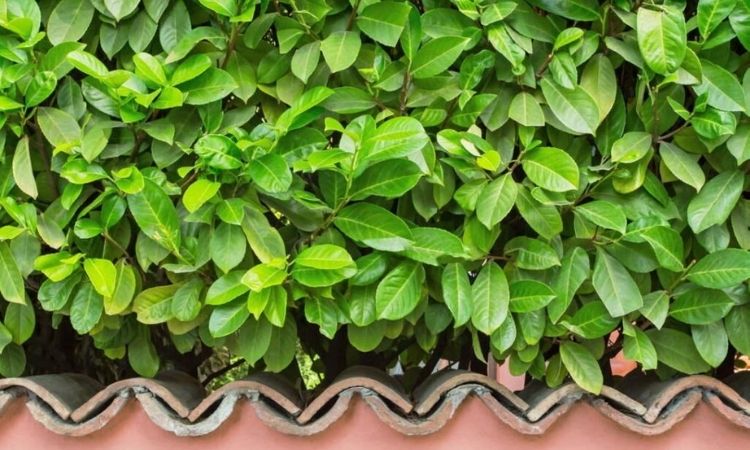
Planting Cherry Laurel
Just by paying attention to a few little things when planting your cherry laurel, you can enjoy a dense, tall hedge or an imposing specimen plant within a few years.
When Should You Plant It?
The best time to plant cherry laurel is in the fall. This will give the plant enough time to root before the first frost, and then it can sprout properly for the first time in the spring. It is best to choose a dry, snow-free, and frost-free day for planting.
Step By Step Planting Instructions
Cherry laurels are considered to be extremely undemanding and robust. Therefore, almost any location is suitable for fast-spreading plants. Whether sun or shade – the cherry laurel already finds its way up. Also to the soil condition does not make special demands. However, it does not tolerate waterlogging. Therefore, loosen very heavy soil with sand and dig up the soil around the planting hole. Once you have found a nice place for your plants, you can start planting:
- Planting distance: 31 – 39 inches
- Dig out the planting holes
- Layout a drainage layer of sand, gravel, or clay shards on the ground
- Mix the excavated topsoil with compost, manure, or horn shavings.
- Place the cherry laurel vertically in the planting hole
- Place root ball so that it sits as deep as in container
- Fill the planting hole and tamp down the soil well
- Water well
To hedges close faster, the planting distance can be reduced to three plants per meter. For container plants, the planting hole should be much larger than the planting container. For balled plants, it is advisable that the roots have spread out space. Also, for balled plants, place the roots in water for about half an hour before planting. During the time your cherry laurel is growing, water as soon as the soil dries out superficially because a lot of water evaporates through the large leaves, which increases the risk of drying out.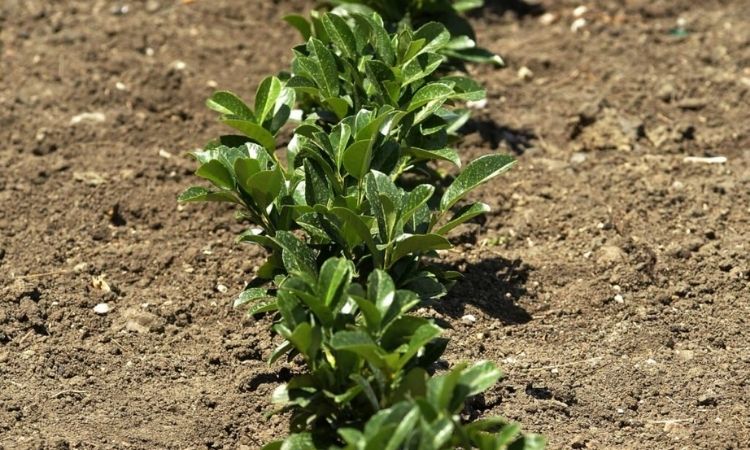
For more on planting cherry laurel, see our special article here.
Propagate Cherry Laurel Yourself
Watch Video: How to Propagate Cherry Laurel from Cuttings
Cherry laurels can be propagated without problems via cuttings or runners. In this way, you can easily fill in gaps in your hedge yourself, for example, in winter or due to disease. Cuttings propagation offers high chances of success even for the novice gardener. It is best to use healthy shoots about 15 cm long as cuttings – these will fall either way several times a year when pruning. For the cuttings to take root, you should proceed as follows:
- Remove lower leaves
- Shorten remaining leaves by half
- Fill a small pot with sand-soil mixture
- Insert the shoot about halfway into the substrate
- Keep the soil well moist, but avoid waterlogging
- Put a foil cover over the pot
- Choose a bright location
- Temperature: about 67 °F
- It takes a few weeks until the roots are formed
The leaves are shortened to minimize evaporation. Also, be sure to avoid waterlogging, so that mold does not form. You can also let the cutting take root in a glass of water and then plant it in the ground. The cutting should be a few centimeters deep in the water. Propagation by seed is also possible. However, both germination and the formation of a proper plant require a relatively long time.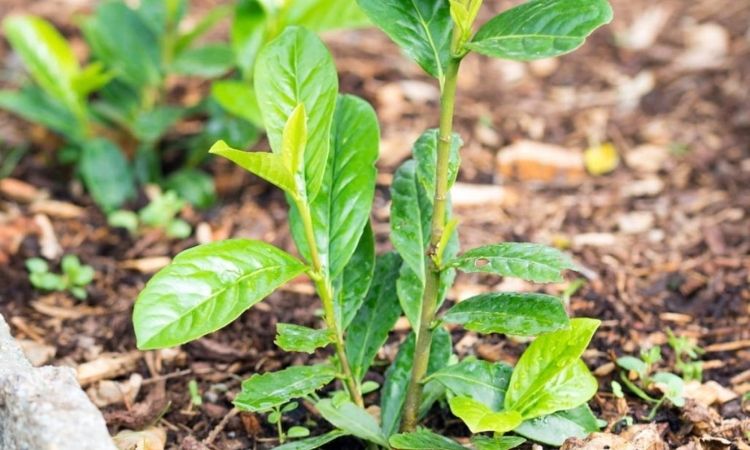
Care For Cherry Laurel
Of course, your cherry laurel also wants to be properly cared for. We have briefly summarized below what there is to consider when caring for it. A more detailed guide to the ideal care of the cherry laurel can be found here.
Watering
Especially on sunny and warm days, it is advisable to reach for the watering can. As a general rule, water the cherry laurel when the soil surface around the plants has dried out. Since the cherry laurel is a deep rooter, you should water the root area thoroughly so that the water also reaches the lower roots. In any case, make sure that you avoid waterlogging.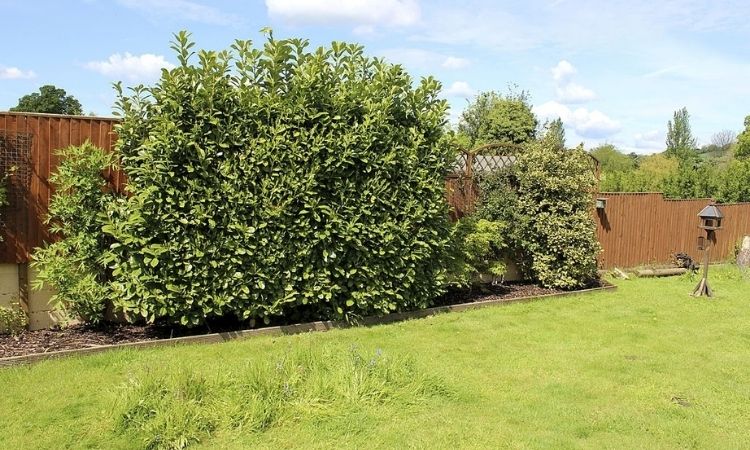
Fertilize
Just like us humans, cherry laurels need a lot of nutrients during their mass phase. In this case, the biceps do not grow, but the shoots gain 15″ per year. Therefore, the supply of your cherry laurel starts at planting. Here, mix the topsoil compost or organic slow-release fertilizer.
Reasonable fertilization will not only make your cherry laurel grow properly but also support the resistance of the plant to frost. If you still want to think about the environment, it is better to leave the fingers of mineral fertilizer variants. These are produced resource-wasting, are worse to dose and usually also more expensive. How you can still optimize the fertilization, you can learn here.
Pruning Cherry Laurel
Regular pruning of your cherry laurel promotes growth and keeps your plants in the desired shape. The first time to prune these fast-growing plants is in the first spring after planting. Thereafter, prune back once or twice a year – depending on how much the variety grows. The first pruning is done in the spring before bud break. Also meticulously remove any winter damage here. This involves cutting back frostbitten or withered shoots deep into the healthy wood.
The second pruning takes place at the end of May to the beginning of June, but at the latest at the beginning of August. Here, an only light pruning is done to shape the plant. Do not choose a day that is too wet or too sunny for pruning, otherwise, there is a risk of fungal infection or sunburn. Also, do not use electric shears for pruning.
These will significantly injure the large leaves, causing the plants to look more disheveled than well-groomed. In addition, the injured leaves will turn brown and unsightly. Good, solid manual work with sharp secateurs offers a remedy.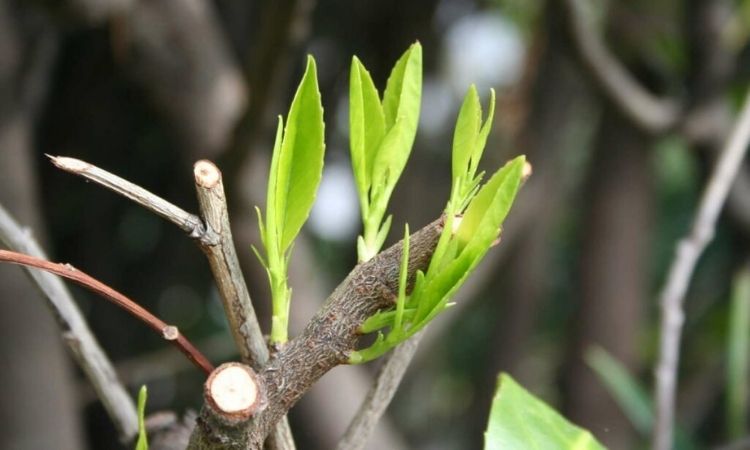
But always work only with gloves and do not touch your face with your fingers. This is because cherry laurel leaves secrete a plant sap on their underside that can lead to contact allergies.
Cherry Laurel: Diseases And Poor Growth
While the rose family (Rosaceae) is considered extremely hardy, it is nutrient and water deficiencies that quickly make them noticeable and lead to increased susceptibility to disease.
Cherry Laurel Leaves Turning Yellow And Brown
There are many reasons why the once vibrant green leaves of your cherry laurel may turn yellow and brown – such as the following:
- Soil compaction and waterlogging
- Sunburn
- Frost and bare frost
- Too little or too much water supply
- Fungal infections
- Lack of nutrients (nitrogen, iron)
- Leaves were injured during cutting (electric scissors)
- Too small pot
- Calcareous soil with too high pH value
- Stress due to change of location
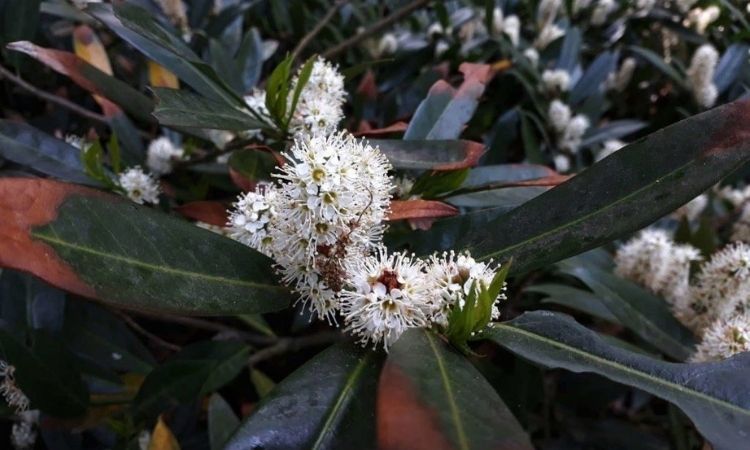
For more detailed information on yellow and brown leaves on cherry laurel and how to prevent them, see this special article here.
Cherry Laurel Loses Leave
That evergreen plants occasionally lose leaves is quite normal. Usually, leaf margin necrosis (brown leaf edges) appear on older leaves before they sail toward the ground. But if the foliage piles up or even all the leaves are shed, there are other reasons. The reasons are the same as for the previously mentioned leaf discoloration because the next stage of this process is the shedding of the damaged leaves. So, proceed here as described in the previous section.
Cherry Laurel Not Growing
If your laurel does not shoot up as expected, this may be due to improper care or simply the growth characteristics of the variety. Therefore, find out about the growth rate of your cherry laurel variety before you get frustrated. You can find particularly fast-growing cherry laurel varieties here. If it’s not due to the variety you’ve chosen, the following are possible reasons for sparse growth:
- Too little / too much water.
- Pests, diseases.
- Too little fertilizer.
- Too little pruning.
- Compacted, heavy soil.
This will allow your plant to get back to its best:
- Water well; avoid waterlogging
- Remove diseased plant parts and fight the pests/diseases (see below)
- Fertilize twice a year (for more information on cherry laurel care and fertilization, click here)
- Prune back twice a year (see above).
- Dig up, improve soil, replant.
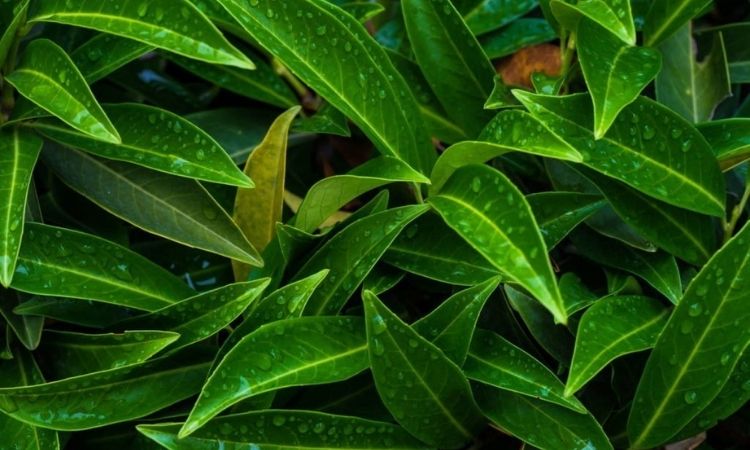
Don’t forget to water, especially in winter. Especially on sunny days, the cherry laurel loses vast amounts of water through its leaves, even in the cold season. Improve the soil by working coarse sand and compost into the soil. When pruning in the spring, cut out the flower buds. This will put all energy into shoot formation.
Common Pests And Diseases
Waterlogging is especially hard on the cherry laurel, but so is stress, as moisture promotes fungal infections. Common diseases of the cherry laurel include:
- Shotgun disease: perforated leaves with red-brown spots.
- Downy mildew: yellow spots on the leaf; white coatings on the underside of the leaf
- Powdery mildew: coating on the upper side of the leaf
In the case of fungal infections, remove and discard the affected leaves to prevent the infection from spreading in the first place. In case of a more severe infestation, especially in the case of powdery mildew, you should consider fungicide treatment. However, to prevent it from getting that far in the first place, you can treat your plants with Algan (Neudorf), for example, and should of course avoid waterlogging.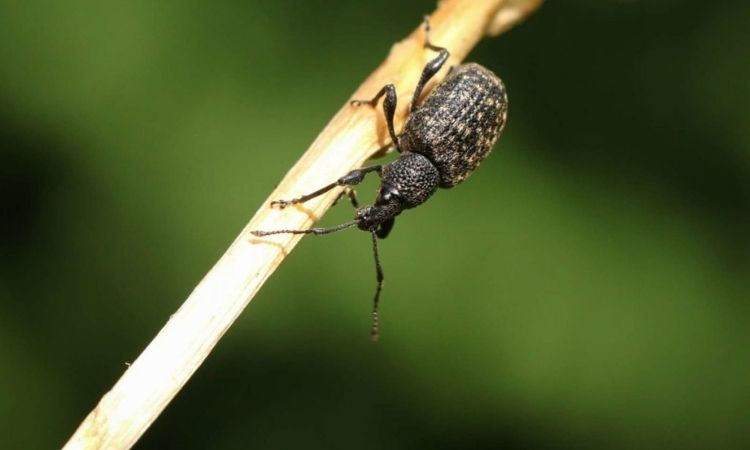
The most common pest is the thick-mouthed weevil, which, as a larva, eats into the roots and thus damages them. As a result, the plant can absorb less water and nutrients, grows weaker, or even dries up at some point. Even when fully grown, the nocturnal beetles are the enemy of every cherry laurel lover, because they eat small bays in the leaf edges.
To combat them, clay pots filled with wood wool are placed under the infested plants. These are used by the beetles as a resting place during the day. The beetles nestled in the wood wool are then disposed of during the day, along with it, and the pots are filled with new wood wool.
Cherry Laurels are ideal for planting as hedges. You can find more low-maintenance hedges that can serve as a screen for your garden in this article.

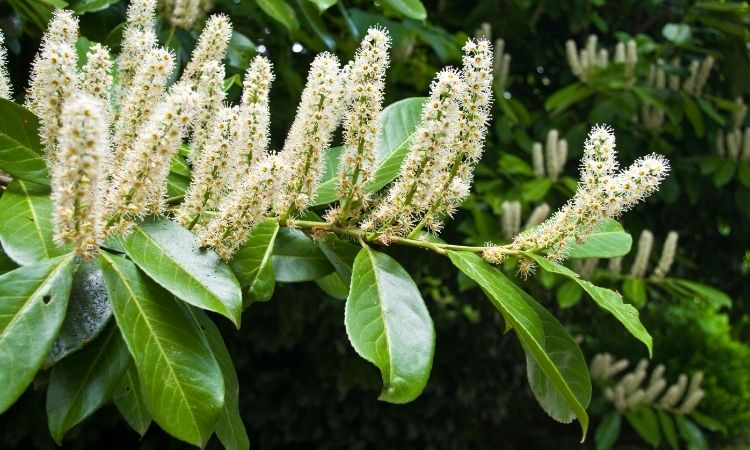
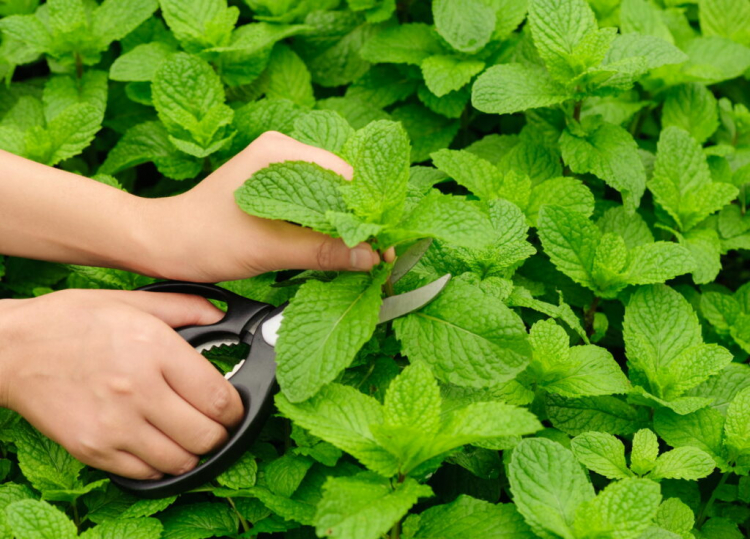

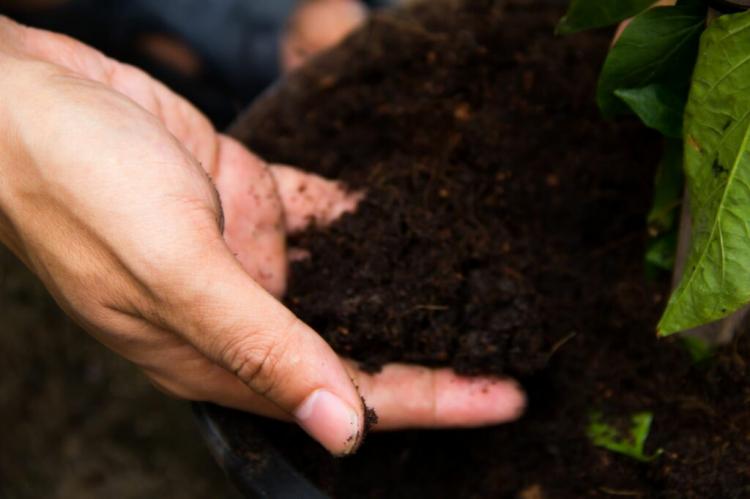

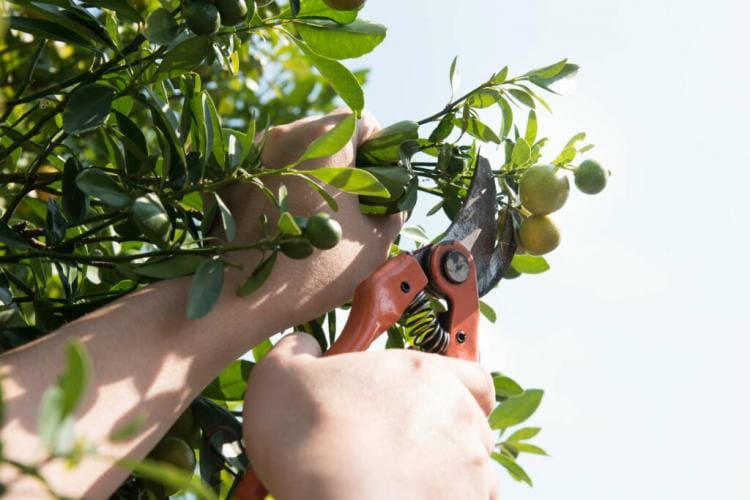

Hi! I just planted a hedge of 13 cherry laurel caucasica. They are currently 40cm height. By when do you recommend that i start pruning? Is there any concrete height when I shall start? In addition, is it recommended to put now in October some organic fertilizer? Any brand in concrete?
Many thanks.